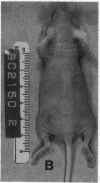Abstract
A strategy for covalent modification of monoclonal antibodies utilizing the oxidized oligosaccharide moieties on the molecule was evaluated and compared to more conventional methods. As judged by quantitative in vitro measurements, a monoclonal antibody conjugate prepared via the oligosaccharides retained the homogeneous antigen binding property and affinity of the unmodified antibody. In contrast, conjugates of the same antibody, modified to the same degree on either lysines or aspartic and glutamic acid side chains, were heterogeneous in their antigen binding and had lowered affinity. In vivo biodistribution and nuclear-imaging experiments were also performed with a second monoclonal antibody and a tumor xenograft model. Antibodies modified on the oligosaccharides with either a peptide labeled with iodine-125 or a diethylenetriaminepentaacetic acid chelate with indium-111 localize into target tumors more efficiently than the same antibody radiolabeled on either tyrosines or lysines. These in vivo results, when compared to those reported in the literature for conventionally modified antibodies, suggest that oligosaccharide modification of monoclonal antibodies is a preferred method of preparing conjugates.
Full text
PDF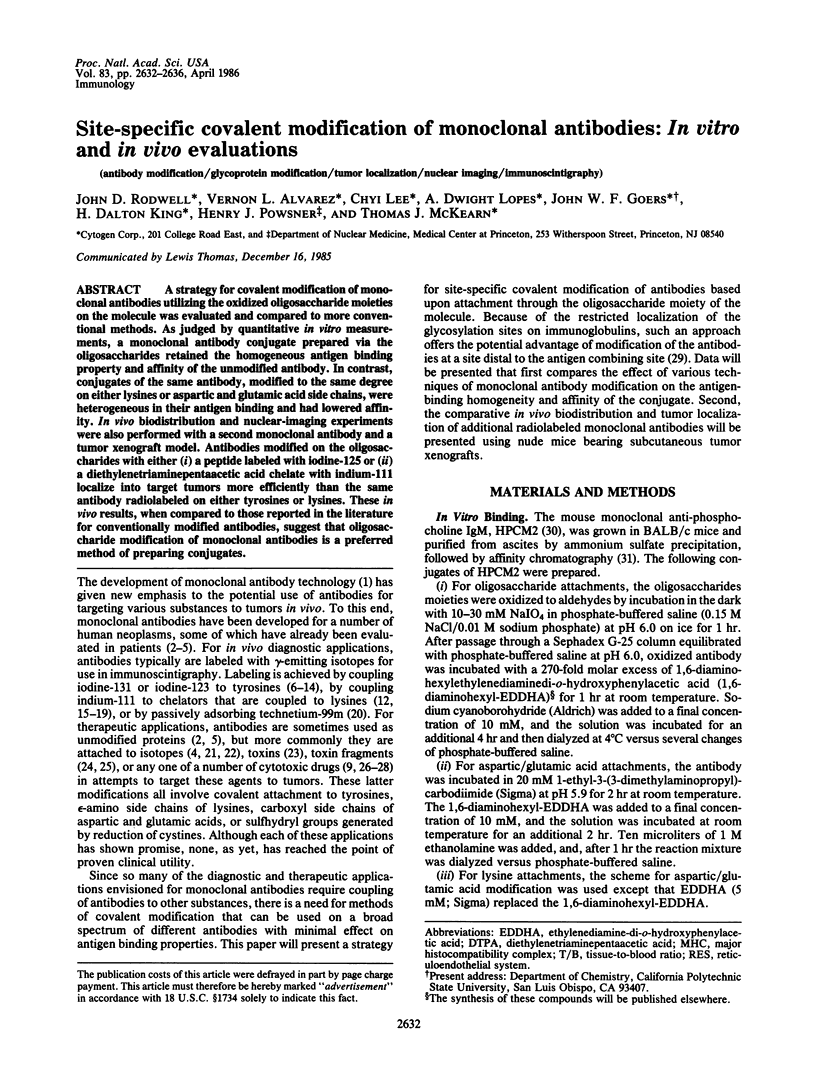
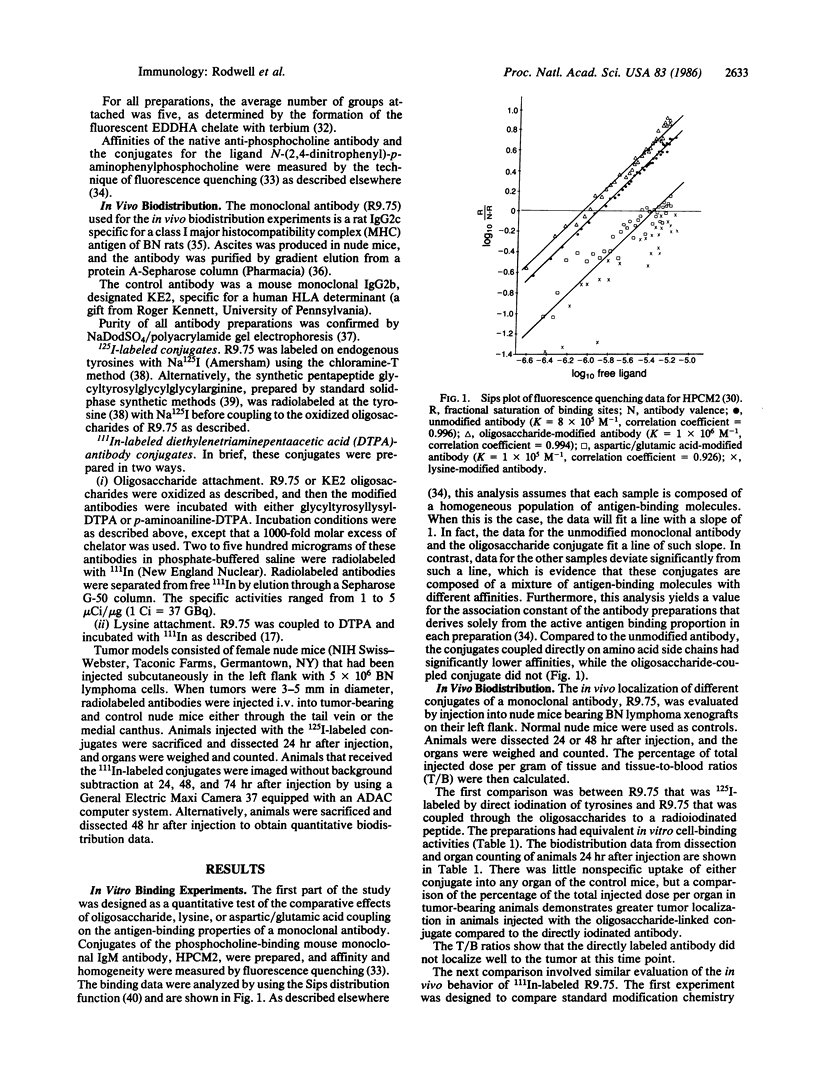

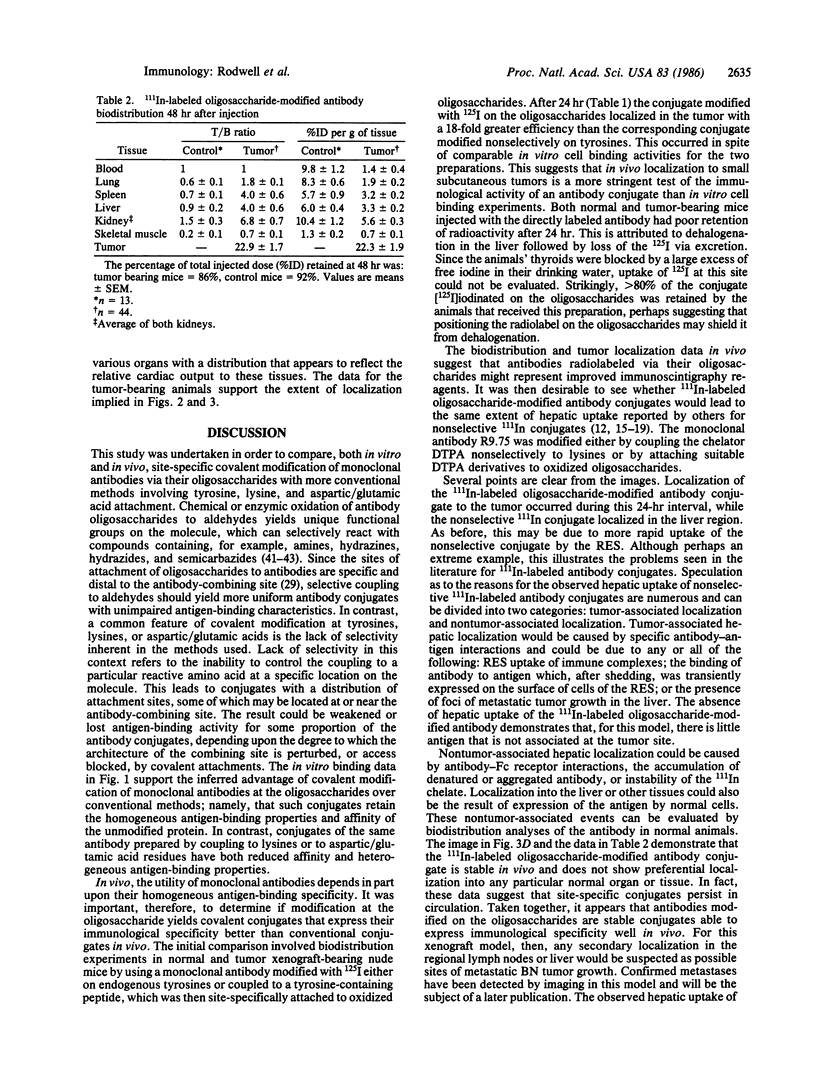
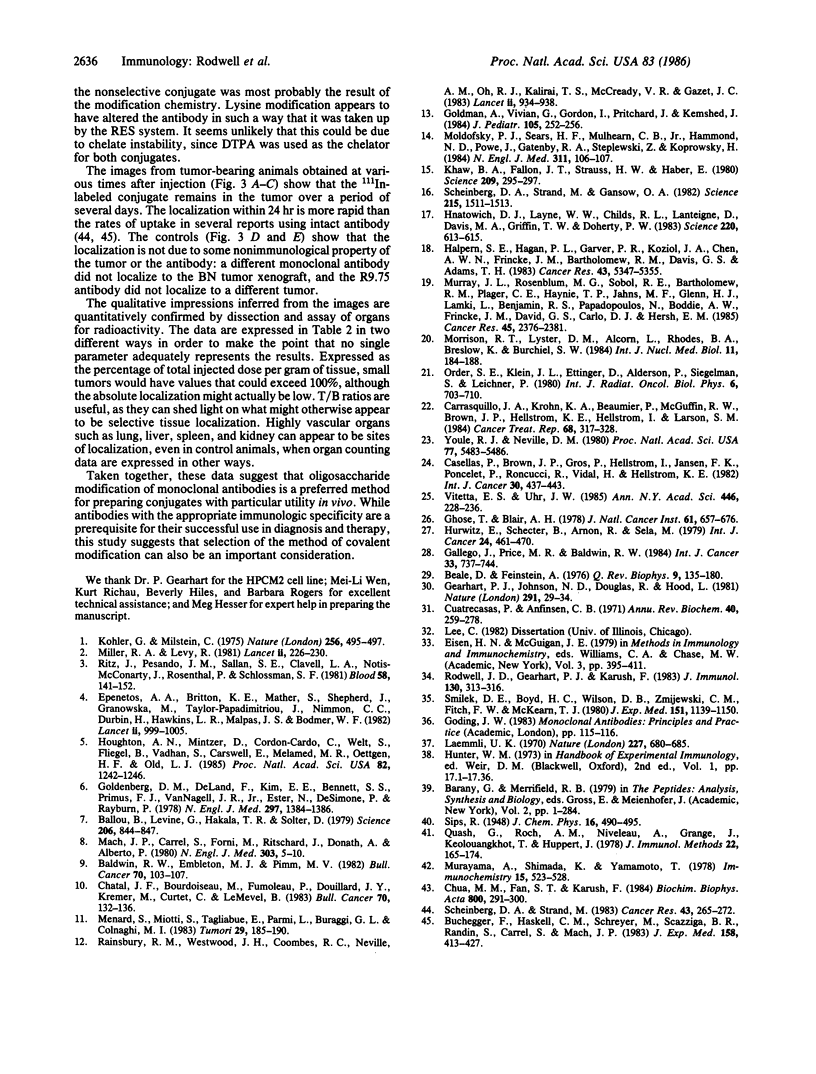
Images in this article
Selected References
These references are in PubMed. This may not be the complete list of references from this article.
- Baldwin R. W., Embleton M. J., Pimm M. V. Monoclonal antibodies for radioimmunodetection of tumours and for targeting. Bull Cancer. 1983;70(2):132–136. [PubMed] [Google Scholar]
- Ballou B., Levine G., Hakala T. R., Solter D. Tumor location detected with radioactively labeled monoclonal antibody and external scintigraphy. Science. 1979 Nov 16;206(4420):844–847. doi: 10.1126/science.493985. [DOI] [PubMed] [Google Scholar]
- Beale D., Feinstein A. Structure and function of the constant regions of immunoglobulins. Q Rev Biophys. 1976 May;9(2):135–180. doi: 10.1017/s0033583500002390. [DOI] [PubMed] [Google Scholar]
- Buchegger F., Haskell C. M., Schreyer M., Scazziga B. R., Randin S., Carrel S., Mach J. P. Radiolabeled fragments of monoclonal antibodies against carcinoembryonic antigen for localization of human colon carcinoma grafted into nude mice. J Exp Med. 1983 Aug 1;158(2):413–427. doi: 10.1084/jem.158.2.413. [DOI] [PMC free article] [PubMed] [Google Scholar]
- Carrasquillo J. A., Krohn K. A., Beaumier P., McGuffin R. W., Brown J. P., Hellström K. E., Hellström I., Larson S. M. Diagnosis of and therapy for solid tumors with radiolabeled antibodies and immune fragments. Cancer Treat Rep. 1984 Jan;68(1):317–328. [PubMed] [Google Scholar]
- Casellas P., Brown J. P., Gros O., Gros P., Hellström I., Jansen F. K., Poncelet P., Roncucci R., Vidal H., Hellström K. E. Human melanoma cells can be killed in vitro by an immunotoxin specific for melanoma-associated antigen p97. Int J Cancer. 1982 Oct 15;30(4):437–443. doi: 10.1002/ijc.2910300410. [DOI] [PubMed] [Google Scholar]
- Chua M. M., Fan S. T., Karush F. Attachment of immunoglobulin to liposomal membrane via protein carbohydrate. Biochim Biophys Acta. 1984 Aug 21;800(3):291–300. doi: 10.1016/0304-4165(84)90408-2. [DOI] [PubMed] [Google Scholar]
- Cuatrecasas P. Affinity chromatography. Annu Rev Biochem. 1971;40:259–278. doi: 10.1146/annurev.bi.40.070171.001355. [DOI] [PubMed] [Google Scholar]
- Epenetos A. A., Britton K. E., Mather S., Shepherd J., Granowska M., Taylor-Papadimitriou J., Nimmon C. C., Durbin H., Hawkins L. R., Malpas J. S. Targeting of iodine-123-labelled tumour-associated monoclonal antibodies to ovarian, breast, and gastrointestinal tumours. Lancet. 1982 Nov 6;2(8306):999–1005. doi: 10.1016/s0140-6736(82)90046-0. [DOI] [PubMed] [Google Scholar]
- Gallego J., Price M. R., Baldwin R. W. Preparation of four daunomycin-monoclonal antibody 791T/36 conjugates with anti-tumour activity. Int J Cancer. 1984 Jun 15;33(6):737–744. doi: 10.1002/ijc.2910330605. [DOI] [PubMed] [Google Scholar]
- Gearhart P. J., Johnson N. D., Douglas R., Hood L. IgG antibodies to phosphorylcholine exhibit more diversity than their IgM counterparts. Nature. 1981 May 7;291(5810):29–34. doi: 10.1038/291029a0. [DOI] [PubMed] [Google Scholar]
- Ghose T., Blair A. H. Antibody-linked cytotoxic agents in the treatment of cancer: current status and future prospects. J Natl Cancer Inst. 1978 Sep;61(3):657–676. [PubMed] [Google Scholar]
- Goldenberg D. M., DeLand F., Kim E., Bennett S., Primus F. J., van Nagell J. R., Jr, Estes N., DeSimone P., Rayburn P. Use of radiolabeled antibodies to carcinoembryonic antigen for the detection and localization of diverse cancers by external photoscanning. N Engl J Med. 1978 Jun 22;298(25):1384–1386. doi: 10.1056/NEJM197806222982503. [DOI] [PubMed] [Google Scholar]
- Goldman A., Vivian G., Gordon I., Pritchard J., Kemshead J. Immunolocalization of neuroblastoma using radiolabeled monoclonal antibody UJ13A. J Pediatr. 1984 Aug;105(2):252–256. doi: 10.1016/s0022-3476(84)80122-5. [DOI] [PubMed] [Google Scholar]
- Halpern S. E., Hagan P. L., Garver P. R., Koziol J. A., Chen A. W., Frincke J. M., Bartholomew R. M., David G. S., Adams T. H. Stability, characterization, and kinetics of 111In-labeled monoclonal antitumor antibodies in normal animals and nude mouse-human tumor models. Cancer Res. 1983 Nov;43(11):5347–5355. [PubMed] [Google Scholar]
- Hnatowich D. J., Layne W. W., Childs R. L., Lanteigne D., Davis M. A., Griffin T. W., Doherty P. W. Radioactive labeling of antibody: a simple and efficient method. Science. 1983 May 6;220(4597):613–615. doi: 10.1126/science.6836304. [DOI] [PubMed] [Google Scholar]
- Houghton A. N., Mintzer D., Cordon-Cardo C., Welt S., Fliegel B., Vadhan S., Carswell E., Melamed M. R., Oettgen H. F., Old L. J. Mouse monoclonal IgG3 antibody detecting GD3 ganglioside: a phase I trial in patients with malignant melanoma. Proc Natl Acad Sci U S A. 1985 Feb;82(4):1242–1246. doi: 10.1073/pnas.82.4.1242. [DOI] [PMC free article] [PubMed] [Google Scholar]
- Hurwitz E., Schechter B., Arnon R., Sela M. Binding of anti-tumor immunoglobulins and their daunomycin conjugates to the tumor and its metastase. In vitro and in vivo studies with Lewis lung carcinoma. Int J Cancer. 1979 Oct 15;24(4):461–470. doi: 10.1002/ijc.2910240414. [DOI] [PubMed] [Google Scholar]
- Khaw B. A., Fallon F. T., Strauss H. W., Haber E. Myocardial infarct imaging of antibodies to canine cardiac myosin with indium-111-diethylenetriamine pentaacetic acid. Science. 1980 Jul 11;209(4453):295–297. doi: 10.1126/science.7384803. [DOI] [PubMed] [Google Scholar]
- Köhler G., Milstein C. Continuous cultures of fused cells secreting antibody of predefined specificity. Nature. 1975 Aug 7;256(5517):495–497. doi: 10.1038/256495a0. [DOI] [PubMed] [Google Scholar]
- Laemmli U. K. Cleavage of structural proteins during the assembly of the head of bacteriophage T4. Nature. 1970 Aug 15;227(5259):680–685. doi: 10.1038/227680a0. [DOI] [PubMed] [Google Scholar]
- Mach J. P., Carrel S., Forni M., Ritschard J., Donath A., Alberto P. Tumor localization of radiolabeled antibodies against carcinoembryonic antigen in patients with carcinoma: a critical evaluation. N Engl J Med. 1980 Jul 3;303(1):5–10. doi: 10.1056/NEJM198007033030102. [DOI] [PubMed] [Google Scholar]
- Miller R. A., Levy R. Response of cutaneous T cell lymphoma to therapy with hybridoma monoclonal antibody. Lancet. 1981 Aug 1;2(8240):226–230. doi: 10.1016/s0140-6736(81)90475-x. [DOI] [PubMed] [Google Scholar]
- Moldofsky P. J., Sears H. F., Mulhern C. B., Jr, Hammond N. D., Powe J., Gatenby R. A., Steplewski Z., Koprowski H. Detection of metastatic tumor in normal-sized retroperitoneal lymph nodes by monoclonal-antibody imaging. N Engl J Med. 1984 Jul 12;311(2):106–107. doi: 10.1056/NEJM198407123110207. [DOI] [PubMed] [Google Scholar]
- Morrison R. T., Lyster D. M., Alcorn L., Rhodes B. A., Breslow K., Burchiel S. W. Radioimmunoimaging with 99mTc monoclonal antibodies: clinical studies. Int J Nucl Med Biol. 1984;11(2):184–188. doi: 10.1016/0047-0740(84)90059-7. [DOI] [PubMed] [Google Scholar]
- Murayama A., Shimada K., Yamamoto T. Modification of immunoglobulin G using specific reactivity of sugar moiety. Immunochemistry. 1978 Aug;15(8):523–528. doi: 10.1016/0161-5890(78)90003-2. [DOI] [PubMed] [Google Scholar]
- Murray J. L., Rosenblum M. G., Sobol R. E., Bartholomew R. M., Plager C. E., Haynie T. P., Jahns M. F., Glenn H. J., Lamki L., Benjamin R. S. Radioimmunoimaging in malignant melanoma with 111In-labeled monoclonal antibody 96.5. Cancer Res. 1985 May;45(5):2376–2381. [PubMed] [Google Scholar]
- Mènard S., Miotti S., Tagliabue E., Parmi L., Buraggi G. L., Colnaghi M. I. Tumor radioimmunolocalization in a murine system using monoclonal antibodies. Tumori. 1983 Jun 30;69(3):185–190. doi: 10.1177/030089168306900302. [DOI] [PubMed] [Google Scholar]
- Order S. E., Klein J. L., Ettinger D., Alderson P., Siegelman S., Leichner P. Phase I-II study of radiolabeled antibody integrated in the treatment of primary hepatic malignancies. Int J Radiat Oncol Biol Phys. 1980 Jun;6(6):703–710. doi: 10.1016/0360-3016(80)90226-6. [DOI] [PubMed] [Google Scholar]
- Quash G., Roch A. M., Niveleau A., Grange J., Keolouangkhot T., Huppert J. The preparation of latex particles with covalently bound polyamines, IgG and measles agglutinins and their use in visual agglutination tests. J Immunol Methods. 1978;22(1-2):165–174. doi: 10.1016/0022-1759(78)90069-8. [DOI] [PubMed] [Google Scholar]
- Rainsbury R. M., Ott R. J., Westwood J. H., Kalirai T. S., Coombes R. C., McCready V. R., Neville A. M., Gazet J. C. Location of metastatic breast carcinoma by a monoclonal antibody chelate labelled with indium-111. Lancet. 1983 Oct 22;2(8356):934–938. doi: 10.1016/s0140-6736(83)90452-x. [DOI] [PubMed] [Google Scholar]
- Ritz J., Pesando J. M., Sallan S. E., Clavell L. A., Notis-McConarty J., Rosenthal P., Schlossman S. F. Serotherapy of acute lymphoblastic leukemia with monoclonal antibody. Blood. 1981 Jul;58(1):141–152. [PubMed] [Google Scholar]
- Rodwell J. D., Gearhart P. J., Karush F. Restriction in IgM expression. IV. Affinity analysis of monoclonal anti-phosphorylcholine antibodies. J Immunol. 1983 Jan;130(1):313–316. [PubMed] [Google Scholar]
- Scheinberg D. A., Strand M., Gansow O. A. Tumor imaging with radioactive metal chelates conjugated to monoclonal antibodies. Science. 1982 Mar 19;215(4539):1511–1513. doi: 10.1126/science.7199757. [DOI] [PubMed] [Google Scholar]
- Scheinberg D. A., Strand M. Kinetic and catabolic considerations of monoclonal antibody targeting in erythroleukemic mice. Cancer Res. 1983 Jan;43(1):265–272. [PubMed] [Google Scholar]
- Smilek D. E., Boyd H. C., Wilson D. B., Zmijewski C. M., Fitch F. W., McKearn T. J. Monoclonal rat anti-major histocompatibility complex antibodies display specificity for rat, mouse, and human target cells. J Exp Med. 1980 May 1;151(5):1139–1150. doi: 10.1084/jem.151.5.1139. [DOI] [PMC free article] [PubMed] [Google Scholar]
- Vitetta E. S., Uhr J. W. The use of immunotoxins containing ricin A or B chains to kill neoplastic B cells. Ann N Y Acad Sci. 1985;446:228–236. doi: 10.1111/j.1749-6632.1985.tb18403.x. [DOI] [PubMed] [Google Scholar]
- Youle R. J., Neville D. M., Jr Anti-Thy 1.2 monoclonal antibody linked to ricin is a potent cell-type-specific toxin. Proc Natl Acad Sci U S A. 1980 Sep;77(9):5483–5486. doi: 10.1073/pnas.77.9.5483. [DOI] [PMC free article] [PubMed] [Google Scholar]







